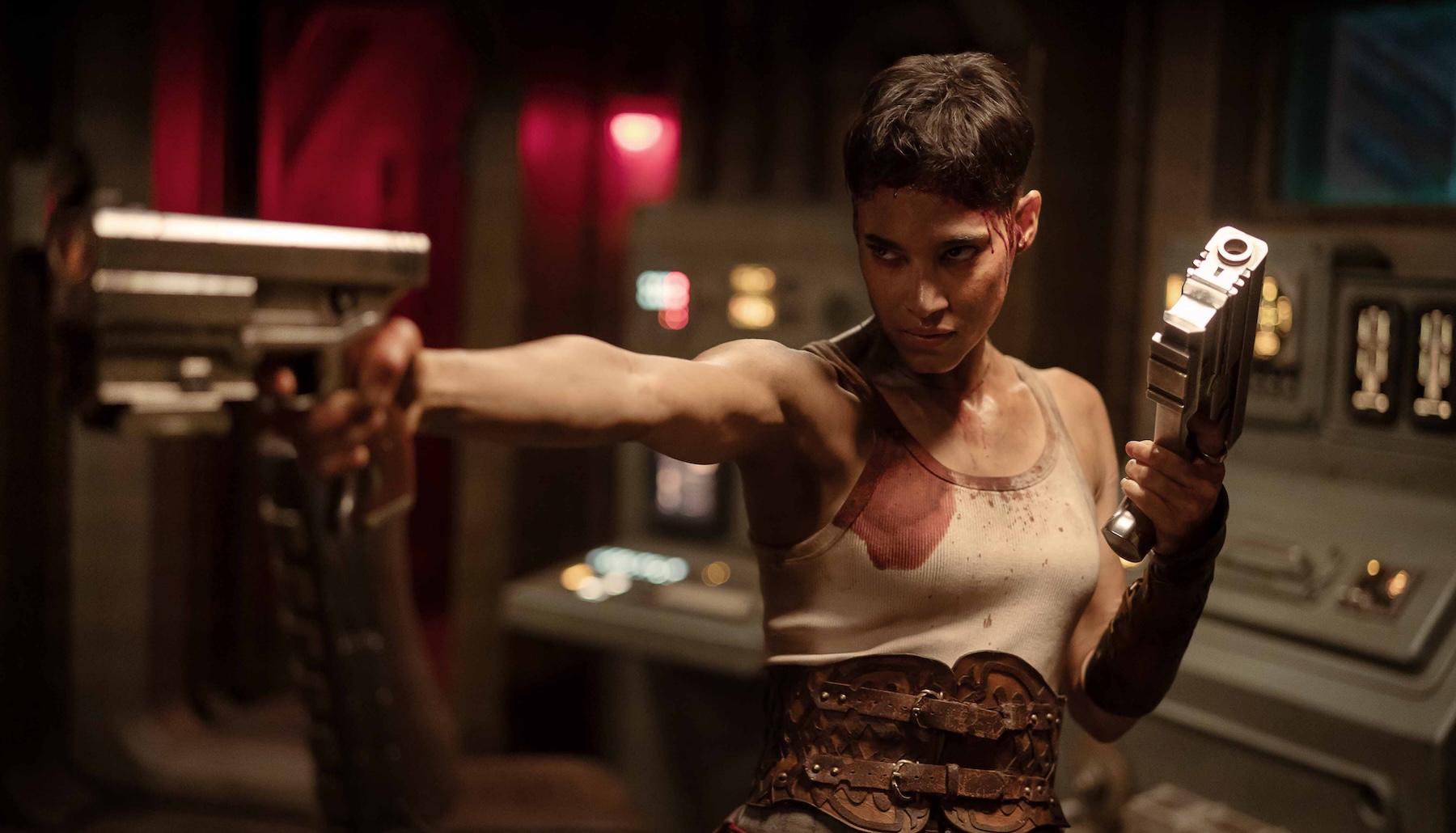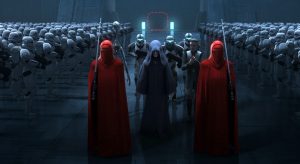
During the extended climax of Zack Snyder’s Rebel Moon – Part Two: The Scargiver, the much debated filmmaker not so much winks at his audience as he vigorously shakes us while shouting in our ear, “Do you get the reference?!” The lonely samurai-like character (read: Jedi), Bae Doona’s Nemesis, stands alone against an army of imperial thugs. She lights up her now familiar glowing machetes that are essentially lightsabers by a different hue, and her opponents each switch on their own. The sequence could have appeared in any one of the Star Wars prequels released in the 1990s and 2000s, or many of the Disney+ shows of today. Except of course for the fact that Nemesis’ blades are red while her foes use blue—and when she stabs one of them with the glowy end, actual bodily fluid seems to come out (although it’s darkened, at least for now in the film’s current PG-13 edit).
On the surface, the imagery is cool, a Snyder trademark. Each of the many speed-ramped moments where the movement slows down to a virtual standstill looks like a still frame from next Christmas’ hottest selling PS5 game. However, I personally couldn’t get over the absolute absence of meaning or stakes to the imagery. This is no besmirching of Doona’s talent. She is given nothing to play but the stoic samurai cliché out for revenge (which is only revealed in Part Two by way of several clumsy and repetitious flashbacks strung together in the movie’s first hour, belatedly trying to offer depth to its eight heroes). Unfortunately, the sequence offers nothing beyond those screensaver poses.
It apes Star Wars because Snyder likes the sleekness of the iconography, but it has little new to say about it, either as a commentary on Star Wars or Rebel Moon’s own counterpoint to that galaxy far, far away. It might reverse the colors George Lucas used to differentiate the good guys from the bad—now the hero uses red and the villains carry blue—but it’s an affectation; a mild distinction that creates enough distance from a Disney intellectual property to avoid legal problems, and which gestures toward a pretense that this universe is edgier. Here the heroine picks a color associated with danger and rage. However, it has no more subtextual significance than it does emotional weight. Like so much else of Rebel Moon, it’s a whole lot of sound and fury signifying nothing.
Chances are if you got this far into the review, you likely already know if you agree or disagree with my assessment. After all, you’ve seen Rebel Moon – Part One, plus any other number of Snyder joints. Like all of those movies, Part Two is helmed by a filmmaker who is by all accounts a nice guy and a cool dude to collaborate with on the set. And there is an undeniable passion in all of Snyder’s work, yet the chasm between that passion and actual quality has probably never been wider than the Rebel Moon exercise where Netflix and the filmmaker took material that would’ve struggled to sustain more than two hours and pointlessly made it run double that across multiple volumes.
Admittedly, Part Two is the unavoidably better portion of the two releases. As the movies’ structure is nakedly modeled after Akira Kurosawa’s Seven Samurai, it pays to have the actual Seven Samurai climax where ronin warriors fight (and in some cases die) for a small village of farmers. And the second half of Scargiver’s two-hour running time is almost exclusively that fight, with every veritable splash page and comic book inspired posture lovingly freeze framed.
Strangely, however, despite having a cumulatively longer running time than Seven Samurai’s already gargantuan 207 minutes, we’re never made once to care about any of the heroes making those poses as they kill space nazis by the scores. As with Part One, every war-weary hero who comes to the Norse-like community living on the moon of Veldt remains a cipher devoid of genuine humanity or life. They’re stoic tropes like the 300 Spartans in Snyder’s most successful action movie, only here the filmmaker no longer has Frank Miller’s cartoonish tough-guy-talk sprinkled in with actual laconic witticisms from ancient Spartans to pad these archetypes with humor and personality. Oh what Rebel Moon could’ve given for a “tonight we dine in Hell!”
Even with a whole hour of down time making up Part Two’s first couple of acts, Rebel Moon devotes precious little of it to having the characters do anything other than enjoy extended montages of farming, drinking ale in the longhouse, and swapping backstories that all hit the same banal note of “the empire killed m’family.” Perhaps the one exception to this rule is our central heroine Kora (Sofia Boutella), who remains the one reformed space fascist of the lot, and she is still haunted by memories of her time in service to the bad guys, including a flashback that reveals what everyone predicted about her in Part One.
Yet the sensation of these added details amount to little better than time filler. It’s a waiting game until the bad guys, led by a dastardly Admiral Atticus Noble (a still mugging Ed Skrein), arrive on Veldt ostensibly to steal this community’s grain, although now also to capture and crucify the turncoat who got away, Boutella’s Kora. One might even speculate whether the filmmakers’ interest is likewise cursory in the first half of Part Two, with many of the farming and day-in-the-life sequences on Veldt resembling any ‘90s syndicated TV show with generic village sets where horses and extras walk around in the background.
Once Part Two finally gets to the action during the hour-long climax, viewers are treated to a sensory overload of Snyder’s speciality: excessive violence with a mean, edgelord sensibility. It’s definitely got an edge, but in the end it makes little sense because there is nothing to invest in, including with who is holding the red lightsabers versus who is holding the blue ones.
Rebel Moon – Part Two: The Scargiver is streaming on Netflix now.
The post Rebel Moon 2: The Scargiver Review – Zack Snyder Definitely Leaves a Mark appeared first on Den of Geek.







